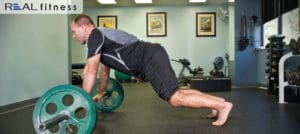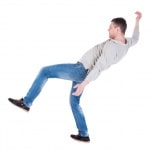May 2020
Low Back Rehab: How Hard Should It Go?
Intensity of exercise is a potent factor in the rate and extent of progress one makes in general fitness and in some injury recoveries. But this has not been thoroughly tested in chronic non-specific low back pain (CNSLBP.) THis is a topic we’ve covered many times here, here, and here .
Recently, Belgian researchers set out to determine if a high intensity cardio and resistance training (HIT) program was better than a lower, more moderate intensity (MOD) one for those with “no clear pathoanatomical cause” for their pain and disability.
After all exclusions from a larger pool, 38 subjects with CNSLBP were assigned to either a HIIT or MOD exercise program for 12 weeks, twice/wk. HIT did 1 minute cycling maximal sprints followed by 1 minute of recovery, with 10 sec added to each sprint each week. The strength work consisted of 3 upper and 3 lower body exercises performed at 80% of their tested maximal abilities, with 5% increases once the subjects could do more than 10 reps for 2 consecutive sessions. Six common static core exercises, like the bridges and side planks, were done 10 times for 10 sec, with the last one held as long as possible.
The MOD group did continuous cycling starting with 14 minutes and progressing up to ~23 minutes at 60% of their max. Strength work was also done at 60% of max, and core work was reduced to only 1 set of 10 reps for 10 sec. with no extra hold.
The HIT routine out-performed the MOD on “disability, pain intensity, function, exercise capacity and isometric back strength” measures.
Large effect sizes were noted, supporting the idea that more intense rehab exercises not only improve relevant performances on cardio and strength tests but also reduce pain and disability better, safely.
MSSE Dec. 2019
HIIT vs MIT: Does Frequency Matter For Overweight Adults?
A consistent winner of fitness trends for the past decade, high intensity interval training (HIIT) has been shown to yield superb health and fitness benefits with shorter time commitments. See this blog and this on the benefits of HIIT. Yes, it’s hard, but it really does work; and it does seem to help reduce weight and body size and composition better than medium intensity training (MIT.) But few studies have compared these benefits in obese and overweight subjects as a function of exercise frequency.
A study out of Hong Kong attempted to ascertain how HIIT done 3-, 2- or once/wk compared to MIT done 1/wk for 8 weeks. In addition to weight and body composition, other cardiovascular and metabolic data was evaluated, such as aerobic capacity, blood pressure (BP) and heart rate (HR), fasting glucose, cholesterol, etc. HIIT consisted of 12 bouts of shuttle runs for 1 min at 90% of maximal ability interspersed with a minute at 70% for recovery; MIT walked continuously for 30 mins at 60%.
Once/wk of HIIT improved aerobic capacity and reduced body fatness; HIIT done 1, 2 or 3/wk reduced body fatness and blood pressure; either HIIT or MIT improved aerobic capacity and body composition but HIIT elicited greater “training efficacy of aerobic capacity”’ and 2-3/wk of HIIT beat 1/wk HIIT and 3/wk MIT.
They concluded, “Altogether, these data suggested that HIIT is a more effective training modality than MICT for aerobic fitness, and HIIT performed even once weekly for 8 wk improved aerobic capacity and reduced body fatness in overweight or obese individuals.” All exercise frequencies outperformed doing nothing, so get moving, faster.
MSSE Jan. 2020
Tid Bits
A multi-center study compared the walking efficiency of older and younger obese and healthy-weight women. Efficiency was based on % of muscle strength required to complete a walking task of self-selected and a constrained pace (1.5 meters/sec.) As expected, relative to the younger women, at both speeds, older women used a higher % of hip flexor and knee extensor strength; obese women used a higher % knee extension and ankle strength. MSSE Jan. 2020
Have you ever grunted or even cursed while trying to lift something heavy…or open a jar of jam? If so, you’re not alone. Two studies (Scand J Pain 10/2017; Neuroreport 8/2017)) have found that swearing may “increase [lifting] performance by as much as 8%, as it helps exercisers deal with discomfort.” The researchers had subjects do an intense exercise uttering a neutral or swear word; greater strength was produced while cursing. concluded that “swearing induces a fight-or-flight response and nullifies the link between fear of pain and pain perception.” Club Business International Feb. 2020
A Journal of the American Medical Association Internal Medicine (JAMA; Sept. 2019) reported that “regular consumption of soft drinks — both sugar-sweetened and artificially sweetened — was associated with a greater risk of all causes of death.” Those who drink 2 or more sodas/day had higher risk of mortality than those who drink 1/month. Based on lifestyle surveys of 451,743 people from 10 European nations taken between 1992 and 2000, it was determined that 2 or more artificially-sweetened beverages/day increased cardiovascular risk; 1 or more/day of sugar sweetened drinks increased risk of deaths due to digestive diseases – gut, pancreas, etc. While not directly causing death, it may be that these drinks are markers of less-than-healthy lifestyles that increase risk. Washington Post Sept. 2019

















